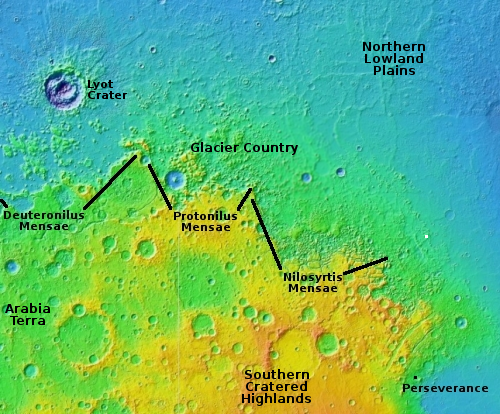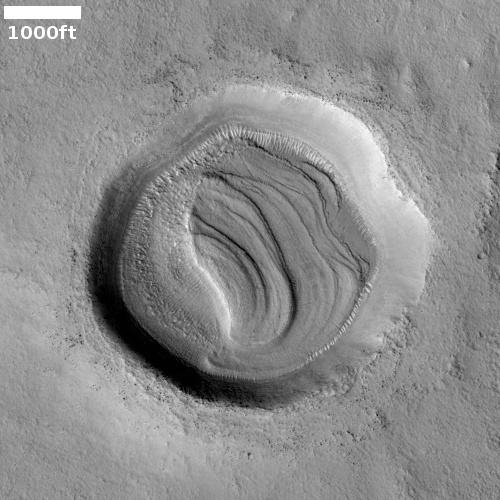A hint at Mars’ past climate cycles
Cool image time! The photo to the right, cropped to post here, was taken on October 28, 2022 by the high resolution camera on Mars Reconnaissance Orbiter (MRO). It shows what the scientists label as a “layered feature” inside a small 4,500-foot-wide crater.
Located at 36 degrees north latitude, we are likely looking at glacial ice layers inside this crater, with each layer probably marking a different Martian climate cycle. The terraces suggest that during each growth cycle the glaciers grew less, meaning that less snow fell with each subsequent cycle. This in turn suggests a total loss of global water over time on Mars.
The overview map below gives us the wider context.

The white dot about 600 miles north of Perseverance marks this crater’s location, at the western edge of Utopia Basin in the northern lowland plains and at the eastern end of the 2,000-mile-long mid-latitude strip I dub glacier country.
There is uncertainty about the cause of the terraces in this glacier-filled crater. Rather than indicate the loss of water over time in Mars’ atmosphere, they might simply indicate the increased rate of sublimation of the upper layers, closer to the surface.
The full image reveals other mysteries. North of this crater are two smaller craters, both also filled with glacial fill but with either few or no terraces. Why? There are also several other craters nearby with either no fill inside at all, or fill that shows no sign of any erosion or sublimation at all.
Why such differences at such close proximity? Your guess is as good as mine.
On Christmas Eve 1968 three Americans became the first humans to visit another world. What they did to celebrate was unexpected and profound, and will be remembered throughout all human history. Genesis: the Story of Apollo 8, Robert Zimmerman's classic history of humanity's first journey to another world, tells that story, and it is now available as both an ebook and an audiobook, both with a foreword by Valerie Anders and a new introduction by Robert Zimmerman.
The print edition can be purchased at Amazon or from any other book seller. If you want an autographed copy the price is $60 for the hardback and $45 for the paperback, plus $8 shipping for each. Go here for purchasing details. The ebook is available everywhere for $5.99 (before discount) at amazon, or direct from my ebook publisher, ebookit. If you buy it from ebookit you don't support the big tech companies and the author gets a bigger cut much sooner.
The audiobook is also available at all these vendors, and is also free with a 30-day trial membership to Audible.
"Not simply about one mission, [Genesis] is also the history of America's quest for the moon... Zimmerman has done a masterful job of tying disparate events together into a solid account of one of America's greatest human triumphs."--San Antonio Express-News
Cool image time! The photo to the right, cropped to post here, was taken on October 28, 2022 by the high resolution camera on Mars Reconnaissance Orbiter (MRO). It shows what the scientists label as a “layered feature” inside a small 4,500-foot-wide crater.
Located at 36 degrees north latitude, we are likely looking at glacial ice layers inside this crater, with each layer probably marking a different Martian climate cycle. The terraces suggest that during each growth cycle the glaciers grew less, meaning that less snow fell with each subsequent cycle. This in turn suggests a total loss of global water over time on Mars.
The overview map below gives us the wider context.

The white dot about 600 miles north of Perseverance marks this crater’s location, at the western edge of Utopia Basin in the northern lowland plains and at the eastern end of the 2,000-mile-long mid-latitude strip I dub glacier country.
There is uncertainty about the cause of the terraces in this glacier-filled crater. Rather than indicate the loss of water over time in Mars’ atmosphere, they might simply indicate the increased rate of sublimation of the upper layers, closer to the surface.
The full image reveals other mysteries. North of this crater are two smaller craters, both also filled with glacial fill but with either few or no terraces. Why? There are also several other craters nearby with either no fill inside at all, or fill that shows no sign of any erosion or sublimation at all.
Why such differences at such close proximity? Your guess is as good as mine.
On Christmas Eve 1968 three Americans became the first humans to visit another world. What they did to celebrate was unexpected and profound, and will be remembered throughout all human history. Genesis: the Story of Apollo 8, Robert Zimmerman's classic history of humanity's first journey to another world, tells that story, and it is now available as both an ebook and an audiobook, both with a foreword by Valerie Anders and a new introduction by Robert Zimmerman.
The print edition can be purchased at Amazon or from any other book seller. If you want an autographed copy the price is $60 for the hardback and $45 for the paperback, plus $8 shipping for each. Go here for purchasing details. The ebook is available everywhere for $5.99 (before discount) at amazon, or direct from my ebook publisher, ebookit. If you buy it from ebookit you don't support the big tech companies and the author gets a bigger cut much sooner.
The audiobook is also available at all these vendors, and is also free with a 30-day trial membership to Audible.
"Not simply about one mission, [Genesis] is also the history of America's quest for the moon... Zimmerman has done a masterful job of tying disparate events together into a solid account of one of America's greatest human triumphs."--San Antonio Express-News


